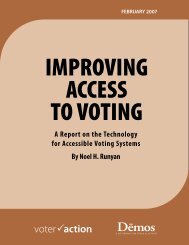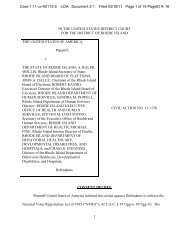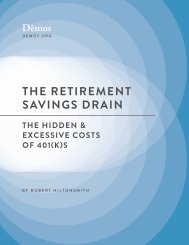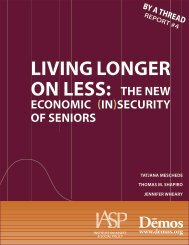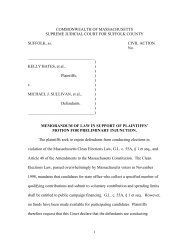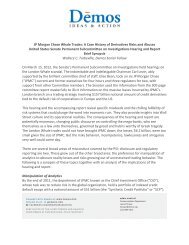Philip Harvey - Demos
Philip Harvey - Demos
Philip Harvey - Demos
Create successful ePaper yourself
Turn your PDF publications into a flip-book with our unique Google optimized e-Paper software.
TABLE 3:<br />
ANNUAL COST OF CREATING 1 MILLION JOBS* IN A DIRECT JOB CREATION<br />
PROGRAM, PLUS AN ADDITIONAL 414,000 JOBS* OUTSIDE THE PROGRAM<br />
Direct Job Creation Program Costs<br />
Estimated Avg. Hourly Wage of UI Recipients Employed in Program $ 17.46 dollars<br />
Estimated Avg. Hourly Wage of Other Program Participants $ 11.70 dollars<br />
Annual Wage Bill $ 26.8 billion<br />
Employer’s share of FICA taxes $ 2.1 billion<br />
Cost of Providing Federal Employees Health Benets (FEHB) $ 5.9 billion<br />
Non-Labor Costs (space, materials, transportation, etc.) $ 11.6 billion<br />
Total Jobs Program Budget $ 46.4 billion<br />
Additional Govt. Revenue and Savings Attributable to Program<br />
Estimated Social Security & Income Taxes Receipts $ 5.4 billion<br />
Estimated UI Savings $ 6.1 billion<br />
Estimated Medicaid and CHIP Savings Due to FEHB Enrollments $ 1.6 billion<br />
Estimated Revenue from Goods & Services Produced<br />
@ avg. of 10¢/dollar $ 4.6 billion<br />
Total Additional Govt. Revenue and Savings $ 17.8 billion<br />
Net Cost of Job Creation Program $ 28.6 billion<br />
Indirect Job Creation Eect of Direct Job Creation Program 414,000 jobs<br />
Source: Author’s calculations using BLS and DOL data.<br />
* Approximately 85% of the jobs in the program (851,000) would be full-time positions. e other 15% (149,000) would be part-time. e<br />
jobs created indirectly outside the program probably would mirror the full- to part-time ratio for the labor force as a whole, approximately 81%<br />
of whose members normally work full time (more than 35 hours per week) and 19% of whom normally work part time.<br />
Assumptions<br />
is cost estimate assumes that jobs program participants could elect to work either full-time or part-time, that they would be oered jobs<br />
consistent with their skills and experience, and that they would be paid the same hourly wage that similarly qualied and experienced workers<br />
receive as new hires in comparable jobs in the regular public and private sector labor market (except that upper-level managers would receive the<br />
equivalent of public rather than private sector managerial salaries).<br />
e estimated average hourly wage of former UI recipients enrolled in the jobs program is based on their estimated prior earnings in covered employment.<br />
e average hourly wage for which other program participants would qualify (ocially unemployed individuals who are not receiving<br />
UI benets, involuntary part-time workers, and persons who want a job but are not actively looking for one) is assumed to equal that of persons<br />
employed part-time in existing jobs in the economy. e estimate assumes that all ocially unemployed workers would accept employment in<br />
the program if it were oered to them, but only 75 percent of involuntary part-time workers and 50 percent the group identied in Figure 1<br />
as discouraged workers. e program cost estimate assumes that the program workforce would be a cross section of these three groups of likely<br />
candidates.<br />
e estimate assumes that program participants would be liable for income, Medicare and FICA taxes on their wages, and that the government<br />
would pay the employer’s share of their FICA taxes as it does for other federal employees. e estimate also assumes that program participants<br />
would receive the same fringe benets, including health insurance, as other federal government employees.<br />
Finally, the program cost estimate assumes that 1 dollar would be spent on non-labor costs (supplies and materials) for every 3 dollars in labor<br />
costs. at was the average ratio of non-labor to labor costs in New Deal direct job creation programs, and it would allow for a reasonable mixture<br />
of public goods and services to be produced by the program today.<br />
e program’s indirect job creation eect has been estimated using a multiplier of 1.29 for expenditures on program wages, 9 1.5 for program<br />
expenditures on health insurance benets, 1.5 for purchases of supplies and capital goods for the program, and 0.0 for payments by the program<br />
of the employer’s share of Social Security and Medicare taxes. e composite multiplier eect of overall spending on the program based on these<br />
partial multiplier eects is estimated at 1.31. It is assumed that payroll employment outside the program would increase by one million jobs for<br />
every 1% increase in GDP caused by the multiplier eect of program spending.<br />
<strong>Philip</strong> <strong>Harvey</strong> 5




